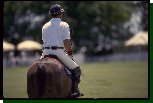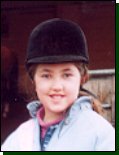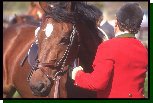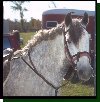 | |  |
 | Riding Gear
 The clothes and equipment you need are designed to keep you safe and to make riding easier and more comfortable. Special, formal clothing is needed for competitions but for riding lessons the clothing you need is more informal. Here are a few guidelines that will help you select what to wear.
These are things you will need: The clothes and equipment you need are designed to keep you safe and to make riding easier and more comfortable. Special, formal clothing is needed for competitions but for riding lessons the clothing you need is more informal. Here are a few guidelines that will help you select what to wear.
These are things you will need:
 Headgear Headgear |
 Boots Boots |
 Riding Clothes Riding Clothes |
 Tack Tack |
| |
 | Headgear
Proper headgear is essential. It must fit you properly and be in excellent condition. Damaged or ill-fitting headgear will not give the protection you need. If you have long hair remember to tie it back.
There are two types of headgear - hard hats and skull caps.
 | Skull Caps
Skull caps are also known as crash helmets. They have a safety harness that fastens around your chin to keep them secure on your head. You can buy a cover for a skull cap with a soft peak at the front. This will help to shield your eyes from the sun or rain. |  |
 | Hard Hats
Although they are still hard enough to give you protection, a hard hat is lighter and less solid than a skull cap. It has a safety harness for security and comfort similar to the one on a skull cap but it does not need a cover because it already has a peak at the front. A hard hat should have a soft peak. Fixed peaks can cause serious damage to you if you fall off your horse. |
The hat you choose is your most important item of riding gear. It may be expensive but you must have the right protection. Hats are sold in specialist shops such as saddlers. | |
 | Boots
Proper boots are very important but unlike a hat, you can buy suitable footwear relatively cheaply. Long or ankle boots are the best footwear to choose.
 | Long boots
Long boots reach up to your knees and should be quite close fitting. They help to protect your legs. Long leather riding boots are expensive but they are strong. Cheaper alternatives are made from rubber. The boots should have a definite heel to stop them sliding through the stirrup. They are sold in specialist shops such as saddlers. |  |
 | Ankle boots
Ankle boots should be made of a smooth leather, without buckles or straps. Jodhpur boots help to protect your ankles when you are riding. The boots should have smooth soles and a definite heel similar to the long boots. Ankle boots with elasticated sides can be found in most shops so you should have no problem finding a suitable pair. |
| |
 | Riding Clothes
 Clothes should be comfortable and casual. Providing they are close fitting, you can wear jodhpurs, riding breeches or jeans. If they are too loose they will be uncomfortable and possibly dangerous - loose clothing can catch on the riding equipment and cause an accident. Clothes should be comfortable and casual. Providing they are close fitting, you can wear jodhpurs, riding breeches or jeans. If they are too loose they will be uncomfortable and possibly dangerous - loose clothing can catch on the riding equipment and cause an accident.
 | Jumpers should be warm but not baggy and a light padded jacket or waistcoat over a jumper will give extra warmth and protection. |
 | Light gloves will stop the reins from irritating on your hands. |
Competition clothes
Competition clothes are smart but practical. They include:
 | a hard hat, navy or black |  |
 | a fitted jacket, red, dark blue, black or tweed |
 | breeches, beige, cream or yellow |
 | a pale shirt |
 | a tie or a stock |
 | black boots |
| |
 | The Tack
The tack, mainly the saddle and the bridle, is the equipment you use when riding a horse. It must be thoroughly cleaned and treated to keep it soft and in good condition each time it is used. Saddlers sell all types of tack but a good riding school or horse association can give you independent advice about what to buy. Riding school horses and ponies have their own tack.
 | The Bridle
The bridle consists of the harness, the bit and the reins. The harness is made from different lengths of leather that are buckled together. The harness holds the bit in the horse's mouth. There are different types of bit and it is important to get the one that suits your horse or pony. An ill-fitting bit can cause your horse pain and make him more difficult to control. The reins are attached to the bit. |  |
 | The Saddle
Saddles support the rider and protect the horse's spine. Stirrup irons on either side of the saddle support the rider's feet. |
Tacking up
If you have your own pony, you will soon learn how to put on a saddle and a bridle. This is called 'tacking up'. A riding school instructor can also show you the right way to 'tack up' if you spend time at a stable helping out. | |
 | Fitness
You do not need to be physically strong to be a good rider but it helps if you are reasonably fit. It also helps if you are supple because you need to be able to move with the horse. Some trainers recommend a basic gymnastics course as a good way to increase your suppleness. Gymnastics can teach you how to fall and roll over so that you don't hurt yourself - a useful skill if you ever lose your balance on a horse! Other instructors might suggest some simple bending and stretching exercises that can help. | |
|
|
|  | |
|  | |
| Copyright ©1997 - British Telecommunications plc | |
|
Last modified on: Tuesday, July 1, 1997.
|



 The clothes and equipment you need are designed to keep you safe and to make riding easier and more comfortable. Special, formal clothing is needed for competitions but for riding lessons the clothing you need is more informal. Here are a few guidelines that will help you select what to wear.
These are things you will need:
The clothes and equipment you need are designed to keep you safe and to make riding easier and more comfortable. Special, formal clothing is needed for competitions but for riding lessons the clothing you need is more informal. Here are a few guidelines that will help you select what to wear.
These are things you will need:



 Clothes should be comfortable and casual. Providing they are close fitting, you can wear jodhpurs, riding breeches or jeans. If they are too loose they will be uncomfortable and possibly dangerous - loose clothing can catch on the riding equipment and cause an accident.
Clothes should be comfortable and casual. Providing they are close fitting, you can wear jodhpurs, riding breeches or jeans. If they are too loose they will be uncomfortable and possibly dangerous - loose clothing can catch on the riding equipment and cause an accident. 

